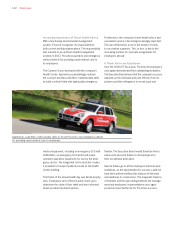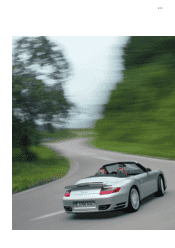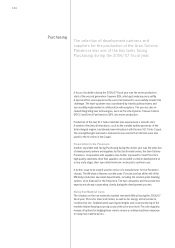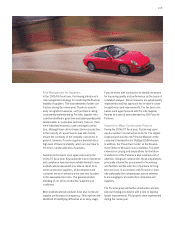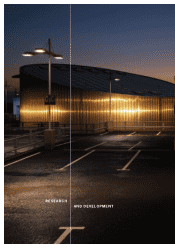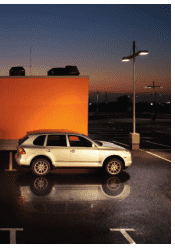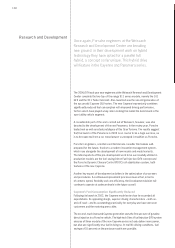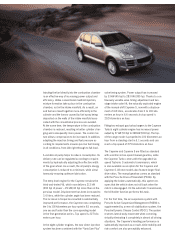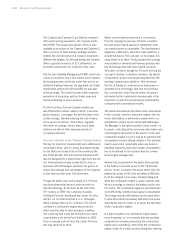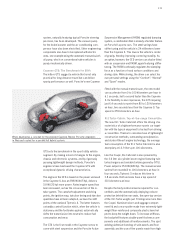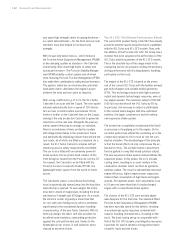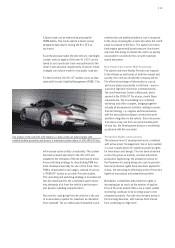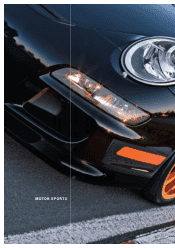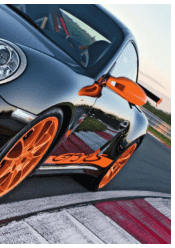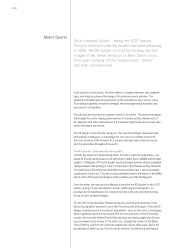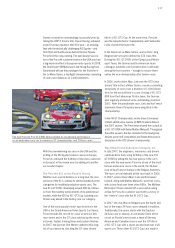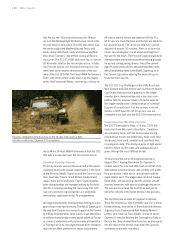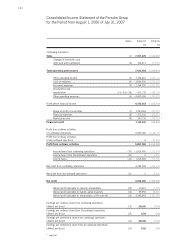Porsche 2006 Annual Report Download - page 114
Download and view the complete annual report
Please find page 114 of the 2006 Porsche annual report below. You can navigate through the pages in the report by either clicking on the pages listed below, or by using the keyword search tool below to find specific information within the annual report.
112
and super-high strength steels of varying thickness –
so-called tailored blanks – for the front and rear side
members have also helped to increase body
strength.
With its specially tuned chassis – which features
the Porsche Active Suspension Management (PASM)
active damping system as standard – the Cabriolet
impressively offers both high levels of safety and
sporty performance. The Porsche Stability Manage-
ment (PSM) stability control system and all-wheel
drive featuring Porsche Traction Management (PTM)
also make their contribution to safety and performance.
The system, which has an electronically controlled
multi-plate clutch, distributes the engine’s power
between the front and rear axles as required.
With a drag coefficient (cd) of 0.31, the 911 Turbo
Cabriolet is on a par with the Coupé. The rear spoiler
extends automatically from a speed of 120 kilome-
ters an hour on both models, but extends 30 mil-
limeters further on the Cabriolet than on the Coupé,
making it the only production Cabriolet to generate
downforce on the rear axle. Alongside the passive
safety system featuring six airbags as standard,
there is an extensive rollover protection system
with integral steel tubes in the windscreen frame
and automatically deploying rollover bars behind the
rear seats, all of which are fitted as standard. As a
result, the 911 Turbo Cabriolet complies with all
statutory passive safety requirements worldwide.
The car is also fitted with an extremely powerful
brake system, the six-piston fixed calipers at the
front being bor-rowed from the Porsche Carrera GT.
On request, the Cabriolet can be fitted with the
Porsche Ceramic Composite Brake (PCCB), the
lightweight brake system from the world of motor
sports.
The Cabriolet’s classic concertina-action folding
hood is automatically stowed away into the hood box
when the top is opened. To save weight, the entire
structure is made of magnesium. Including the drive
mechanism, it weighs just 42 kilograms. As a result,
the vehicle’s center of gravity is lower than that
for cars with vario folding roofs, which contributes
significantly to the exceptional dynamic handling
characteristics of the new Turbo Cabriolet. With its
three-ply design, the fabric roof also provides for
excellent noise insulation, outstanding protection
against the cold and the heat and, thanks to the
heated glass rear screen, is well suited for every-
day use at any time of year.
The 911 GT2: The Ultimate Performance Athlete
The current 911 product family (code 997) has already
proven its extreme sports and performance capabilities
with the 911 Turbo and 911 GT3 models. Now, with
the addition of the Porsche 911 GT2, the family has a
member that even surpasses the performance of the
911 Turbo and the sportiness of the 911 GT3 models.
This is the absolute top-of-the-range model in the
road-going sports car program, uniting extraordinary
driving performance with exciting dynamic handling,
particularly on the track.
The engine of the 911 GT2 is based on the power
unit of the current 911 Turbo with the familiar exhaust
gas turbochargers and variable turbine geometry
(VTG). This technology ensures both high maximum
output and dynamic turbocharger response, even at
low engine speeds. The maximum output of 390 kW
(530 hp) exceeds that of the 911 Turbo by 50 hp.
In particular, this increase in output is attributable
to the revised turbochargers with flow-optimized
turbines, the larger compressors and the entirely
new expansion intake system.
The system has completely revolutionized the famili-
ar processes of supplying air to the engine. So far,
an intake system has utilized the oscillating air in the
compression phase to force more air into the com-
bustion chamber. The disadvantage of this principle
is that the boost effect not only compresses the air,
but warms it too. The air/fuel mixture cannot there-
fore be ignited in a way that would optimize output.
The new expansion intake system instead utilizes the
expansion phase. In this phase, the air is actually
cooling down, resulting in a cooler mixture in the
combustion chamber which can then be ignited to
optimize output. The result is substantially improved
engine efficiency, higher engine power output and
reduced fuel consumption at high loads and engine
speeds. At maximum power, fuel consumption is up
to 15 percent lower than that of a turbocharged
engine with a conventional intake system.
The chassis of the 911 GT2 uses actively adjust-
able dampers for the first time. The standard-fitted
Porsche Active Suspension Management (PASM)
has been specially tuned for this vehicle, resulting
in an extremely sporty response combined with
superior handling characteristics, including on the
track. The basic tuning set-up is comparable with
that of the 911 GT3 models, providing the necessary
essentials for superb dynamic driving performance
on public roads and wet tracks.
Research and Development


